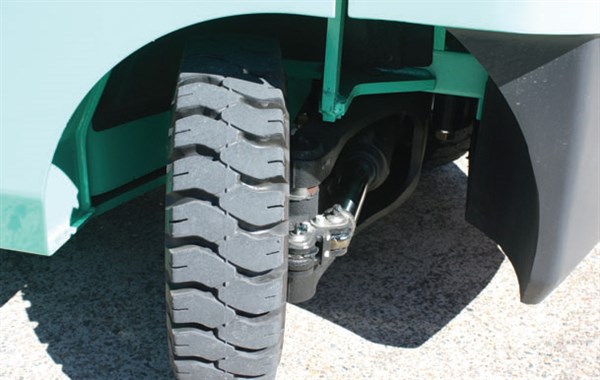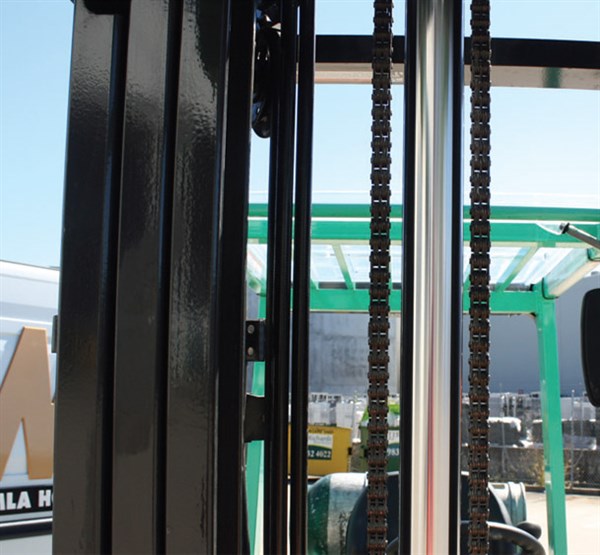Mitsubishi may not have rewritten the rule book with the Grendia range of forklifts but there’s still a ready market in Australia for this kind of machine
Given some of the all-singing and all-dancing electric machines that have graced these pages you may be forgiven for thinking that the traditional Internal Combustion (IC) forklift is dead. In fact I’ve even quoted industry figures that indicate that battery electric materials handling equipment now accounts for 53 per cent of all machines sold on the Australian market.
That figure includes electric materials handling equipment ranging from pedestrian pallet movers to stock pickers and reach trucks. One thing to take into account though is the growth in warehousing roles that use horizontal pallet movements, roles that use a lot of electric machines, such as, low level order pickers, end rider pallet trucks and walkie pallet trucks. At this stage, maybe this can account for the rise of the electric machines rather than the death of the gas or IC truck, for the time being anyway.
Internal Combustion or Battery powered forklifts?
The question still remains though: who is still using the old school IC truck? The answer would appear to be wide ranging but there are still a number of roles where the IC truck still shines. An obvious one would be transport company roles; another good example would be the produce markets in our capital cities. Some of the key characteristics of this sort of work are the inconsistent work flow and the long, sometimes intensive periods of activity.
For example, many trucking companies run flat-chat for a few hours in the morning loading and unloading trucks, often outside, and often on uneven surfaces. This work load can be unpredictable, fluctuating throughout the day as trucks roll in and out of the depot and work generally reaches fever pitch again late afternoon and evening. While battery technology has improved in leaps and bounds over the last few years and no doubt will continue to do so, batteries are like kids, they thrive on routine. Regular charge and discharge maximises battery life and charge life, inconsistency shortens both. As Murphy’s Law would have it you’ll always need to change a shift battery right when it’s the most inconvenient.
There are no doubt other factors at play; some operators prefer the smaller initial outlay of a IC machine even though the cost of ownership over a number of years tends to tip the scales in favour of electric. One big factor is the need for charging and battery changing infrastructure, though IC trucks still need either gas or diesel refuelling. Another common factor not often talked about is that IC trucks, made up of familiar automotive components, such as pistons, gearboxes and radiators rather than batteries and circuit boards, are currently still an easier sell. Again the key point is, this may change.
The Mitsubishi Grendia
The Mitsubishi Grendia range of IC trucks pretty much typifies the traditional 1.5-2.5-tonne capacity gas truck that we’re all so familiar with. While the range encompasses capacities from 1-tonne to 3.5-tonne, it’s smack in the middle of this weight range where you find the bulk of the action in the Aussie market. Distributed in Australia by MLA Holdings, the Grendia is interesting in that Mitsubishi haven’t chosen to supplement its line-up with a separate budget brand as some other materials handling companies have done. Rather, the company offers a budget carburettor inducted version (the FG) or a higher spec version that uses electronic fuel injection (EFI) ― this model is the FGE. As the FGE uses a computerised engine management system it can be easily speed limited and programmed to meet a customer’s requirements.
The EFI version is claimed by MLA to represent a 40 per cent gain in fuel economy over the carby model. But another factor worth pointing out is that the truck is equipped with a three way catalytic converter to cut down on exhaust emissions. There’s also a Power or Soft setting to regulate how the engine puts power to the ground; the Soft setting is claimed to reduce CO2 emissions by up to 13 per cent.
I had a chance to take a closer look at the Grendia recently at MLA’s Wetherill Park facility in Sydney’s industrial west. The green machine pictured here is the carby equipped base model FG18. Apart from the distinctive colour, there’s nothing that immediately grabs you about this forklift other than the fact that it looks pretty much like any other 1.8-tonner you stumble across in an industrial suburb.

Cab and Controls
Up close you can appreciate some of the finer points of the machine. Under the suspended driver’s seat lies an integrated presence system (IPS) switch, which locks out all of the trucks functions unless the driver is actually sitting on the seat.
The seat has a weight dial that lets the operator select their weight to make sure the switch disengages, otherwise, if you happen to be a dainty little thing like me you won’t be able to get the machine to move.
At the top of the tilt adjustable steering wheel is a digital instrument panel that features most of the usual info, such as, engine hours and speed. Another neat feature is an integrated digital weight gauge, while not accurate enough to be working out legal payloads for trucks, it does prevent the forklift from being overloaded and will set off an audible alarm if the trucks safe working weight limit has been exceeded.
Overhead is a clear Perspex roof that come fitted to the truck, though in this case it also has rain gutters. I for one have had the pleasure of wearing a roof full of cold rain water after hitting the brakes on a forklift outside in the rain, it’s a thrilling experience…not. Another point is that you can easily enter or exit the truck from either side as the control levers are high enough to swing past ― quite handy if you need to get out in a hurry.
Performance
I took the FG18 for a spin outside, and while I didn’t handle a load it was still an intuitive machine to operate.
The pedals are mounted through the floor rather than suspended, which tends be more comfortable over long periods and the fork control levers are within in easy reach at all times.
The 180 degree wheel cut also gives the FG a sensational turning circle. The 3-stage container mast provided reasonable visibility with the hydraulic hosing routed outside the field of view.
I also noted that all of the daily fluid-check points are easy to get to and accessible from the left hand side of the machine, which makes the job that bit easier.
Verdict
The recent merger between the materials handling divisions of Mitsubishi Heavy Industries and Nichiyu in Japan may well point to a new direction for Mitsubishi.
As the capability and versatility of electric machines continues to improve, the domain of the IC truck may well start to contract. However, until that happens trucks like the FG18 will continue to keep the wheels of industry and transport turning.




